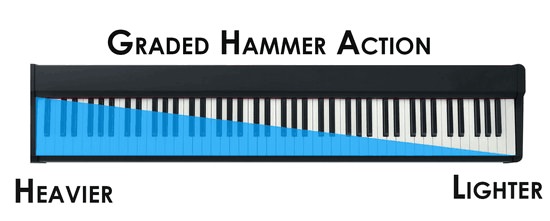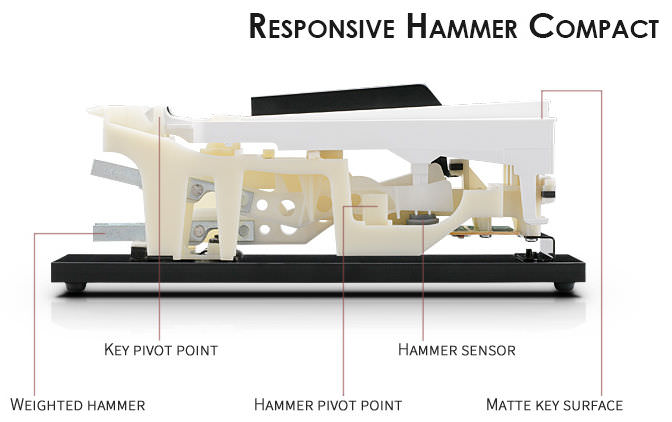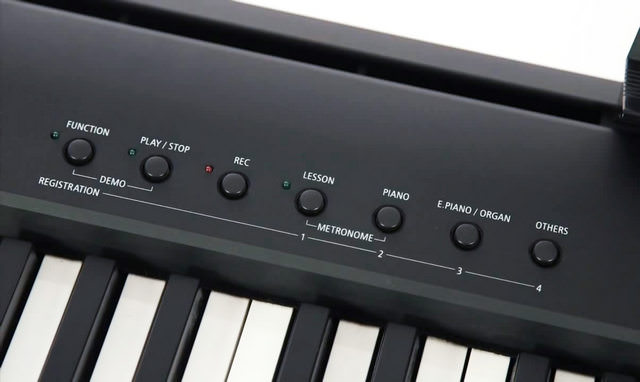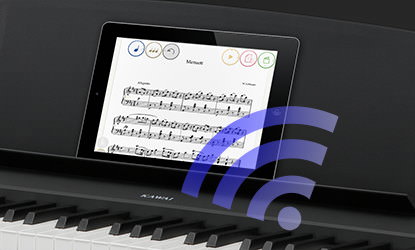
Table of Contents
When you consider its price point, the Kawai ES110 has a lot to offer. Even though this piano includes only 19 sounds, a musician who moves from gig to gig will enjoy this instrument. With realistic sound, decent weighted keys, and some phenomenal connectivity options, this is a nice piano. It is hard to believe that all this and more has been packed into a piano that weighs only 26 pounds. The fact that the Kawai ES110 is so lightweight makes it awesome for traveling musicians.
Kawai ES110 Features
- Lightweight for easy portability
- Excellent speaker system
- Dynamic feedback from the keyboard
- Excellent electric piano and acoustic piano tones
- Connection via Bluetooth.
Playing the Kawai ES110
The piano used for stage performance must have excellent sound quality, be portable, and have the ability to connect to other devices. Even though it may have excellent features, it must also be easy and fun to play.
While the Kawai ES110 may not be very aesthetically pleasing, it is an awesome instrument to play. The feel and weight of the keys are very surprising, but overall it responds very well. You will not notice any vibration and feedback like you do with an acoustic piano. This piano plays and feels like an instrument at a much higher price point.

The Kawai ES110 uses the Responsive Hammer Compact action technology. You will notice a fast response time to playing a key. This is due to the sensor being located near the key’s middle rather than at the end. This makes a keyboard that feels better than keyboards with a springier touch that cost about the same as this one.

Sound
The range of sounds provided by the Kawai ES110 will be adequate for most situations. You will find that this instrument is easy to use for performing but will also be a great addition to a home studio.
The piano comes with 8 sounds: Concert Grand, Concert Grand 2, Studio Grand, Studio Grand 2, Mellow Grand, and Mellow Grand 2, Modern Piano and Rock Piano.
When you turn on the piano, the rich clarity of the Concert Grand will be used. While you may notice a loss of bass frequency, the piano usually does a great job providing an acceptable range. The top frequencies provide a liveliness that makes playing a pleasure.
You will notice a nasal tone when you use Concert Grand 2. The tone is heavy around middle range of the spectrum. This is a very popular setting for playing classical music. When combined with the ES110’s key action, this is a very pleasing sound.
For a more dynamic response, select Modern Grand. When this option is used in connection with the excellent key action provided by the ES110, you will have a wide range of expressing yourself when you play.
When you select Studio Grand, be ready for an aggressive sound. This option would work well if you are playing with a band. It provides such good clarity that you will hear it easily at higher volumes. The sounds from the Studio Grand setting lack warmth and feel digital or electronic when used for performing. This setting would be most useful when the keyboard is being played as a part of a band.
When playing jazz music, you would want to select Modern Piano as it has a warm feeling that Studio Grand lacks. When you want a mid-range aggressive sound, select Rock Piano.
You will find all the sounds pleasant, it is just a matter of preference. You will enjoy having the ability to alter your default musical tone when you first turn the keyboard on. An option allows you to save as many as four arrangements that will then be available for use instantly. This keeps you from having to reset these features each time.
When you have the opportunity to perform live, you will be able to power off or on the onboard speakers. You will enjoy having this speaker for at home practice and learning. The volume and clarity of the speaker is very high quality. It also has a round speaker that produces a quality organ sound.
With over 100 preset drum tracks, this instrument is ready for any jam session. This feature is a bit uncertain, however, as the sounds fade quickly and are difficult to control. Also, they do not respond to the way you are playing. The drum feature is something that is more for enjoyment rather than use as a professional pianist.
User Interface

Surely you knew that somewhere in this review there had to be some negatives. Unfortunately, the user interface is this model’s downfall.
Why? You might ask. The Kawai ES110 lack a digital display so to access the various piano modes, you must press the key labeled PIANO multiple times to change modes. This is a very outdated method and is very difficult to use. You have no confirmation of the mode you have selected.
Connectivity

When it comes to connectivity, the Kawai ES110 does not disappoint. The included Bluetooth connection (4.0) lets you hook up wirelessly to an iPad, iPhone, or Android device. Also, through Bluetooth, you can connect to Kawai’s app, the Virtual Technician. You will find this app as a free download. When using the app, you have the ability to edit any sounds just like you were a professional piano tuner. You can alter the key off effect, voice aspects, resonance and noise of the damper and strings, and the TouchCurve.
This very impressive feature makes this piano an asset to any home studio. You have complete control over your sound specifications.

You will also find the connections that other keyboards have – a damper pedal connection, and in/out MIDI connection, two 1/4 inch headphone jacks and a 1/4 line out connection.
Kawai ES110 Videos
Summary
At the price point, it is hard to find many flaws with the Kawai ES110 piano. The lightweight is invaluable to anyone who likes to play gigs and use a portable instrument. While the touch is a bit sticky, the keyboard still has a nice feel and is very easy to play. Beginners would enjoy using this piano for practice and performance for many years. Once you become a more skillful pianist, you will still enjoy this portable keyboard when you want to take your music with you.